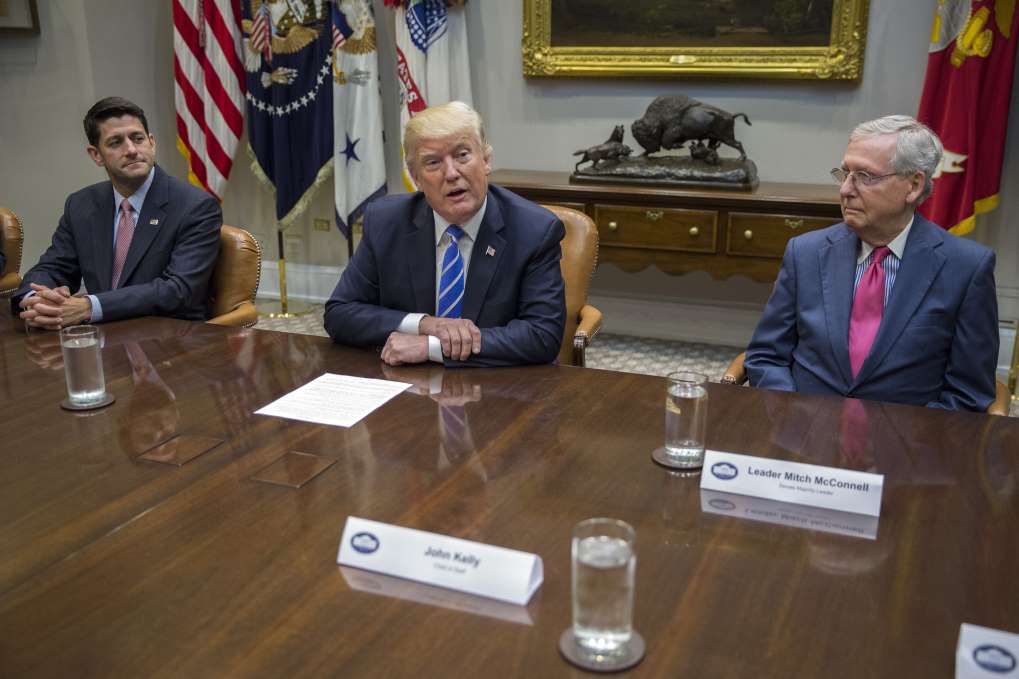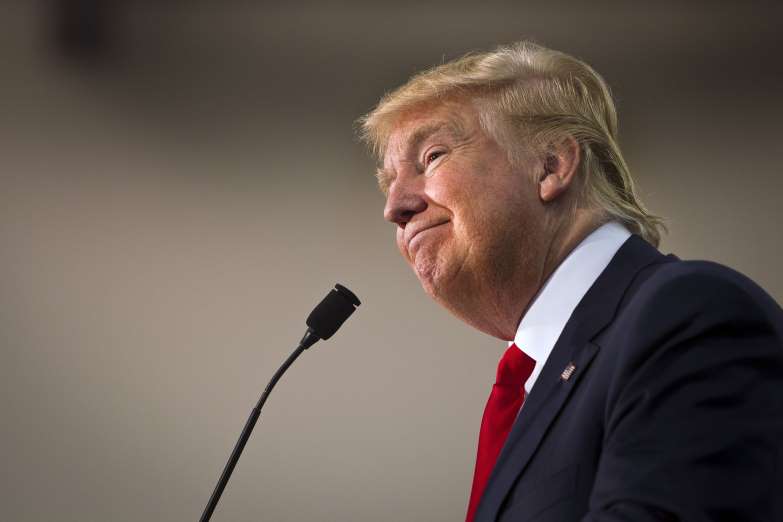September 22, 2017
Republicans are targeting a corporate rate of 20 percent in their federal tax overhaul plan, according to three people familiar with the emerging blueprint — a number that represents a substantial cut from the current 35 percent rate but falls short of the 15 percent President Trump has long pushed for.

September 22, 2017
Republicans are targeting a corporate rate of 20 percent in their federal tax overhaul plan, according to three people familiar with the emerging blueprint — a number that represents a substantial cut from the current 35 percent rate but falls short of the 15 percent President Trump has long pushed for.

President Trump speaks as Senate Majority Leader Mitch McConnell (R-Ky.) and House Speaker Paul D. Ryan (R-Wis.) listen during a meeting regarding tax reform at the White House on Tuesday, Sept. 5, 2017. – Bloomberg
The plan remains fluid, said the Republicans, who spoke on the condition of anonymity to describe sensitive negotiations. But they said the template is taking a more definite shape ahead of a planned rollout next week by the “Big Six” negotiators from the White House, Senate and House.
This week, key members of the Senate Budget Committee reached a deal on the potential fiscal impact of the tax overhaul, agreeing to add as much as $1.5 trillion to the budget deficit over the next decade to accommodate the anticipated revenue lost under the GOP plan. Republicans believe the corporate rate cut and other incentives will stimulate economic growth, offsetting the revenue loss.
In another bid to spur immediate growth, Republicans familiar the emerging details said, the plan will also allow “full expensing,” which permits businesses to fully deduct their capital expenses immediately rather than writing off their depreciation over the course of several years. But that provision, they said, will not be permanent but will sunset after five years due to its cost.
Grover Norquist, president of Americans for Tax Reform, said a 20 percent corporate rate combined with five years of expensing would achieve the GOP’s long-standing tax objectives. Norquist has been involved in the plan’s drafting but is not one of the Republicans briefed on the latest details.
“That will kick-start the economy in a way that reelects every Republican who has a vowel in his name,” he said Friday.
But it also is an implicit brushback of Trump, who as recently as this month has called for a 15 percent corporate rate to make U.S. companies more competitive across the globe.
“Right now, we’re paying the highest tax rate in the world. We want to bring that to around 15 percent,” Trump said on Sept. 14. “That would make us competitive with China and other countries.”
Key congressional leaders, however, have long doubted whether they would be able to push rates that low, given the potential lost revenue and their desire to pursue other costly provisions, including full expensing and a suite of changes to the individual tax code.
Representatives for each principal GOP negotiator — the Trump administration, House Speaker Paul D. Ryan (R-Wis.), Senate Majority Leader Mitch McConnell (R-Ky.), the Senate Finance Committee and the House Ways and Means Committee — declined to comment on details of the emerging plan.
Vice President Pence stumped for the tax bill in his home state of Indiana on Friday, saying the GOP bill would lower taxes on businesses and individuals and create economic growth. “Tax cuts mean more jobs, tax cuts means higher wages for our families, tax cuts will create an economy where anything is possible,” he said.
While the 20 percent corporate rate falls short of Trump’s goal, the emerging outline also represents a retreat for some congressional players. Ryan and Rep. Kevin Brady (R-Tex.), the Ways and Means Committee chairman, have both pushed for full expensing and have emphasized the importance of making the corporate tax provisions permanent. The sunset for full expensing could mean a brief spurt of business investment, but it could also impede long-term planning.
Norquist, however, predicted the provision, if enacted, would simply be extended indefinitely by Congress down the road — much as it has continued other corporate tax provisions, such as the existing credit for research and development costs.
On the individual side, Republicans have indicated plans to deliver tax relief to the middle class by doubling the standard deduction and reducing the current seven tax brackets to three. But they also have expressed a willingness to end a popular deduction for state and local taxes that is claimed by many middle-income filers in high-tax states.
While the emerging details signal progress toward a consensus Republican bill, the plan faces multiple serious hurdles before it can be enacted into law.
As a preliminary measure, the House and Senate must agree on a budget resolution that sets out the fiscal parameters of the tax plan. This week’s Senate accord signaled progress on that front, but House conservatives have pushed to include hundreds of billions of dollars of spending cuts rather than simply focusing the budget on tax cuts. Budget hawks in both chambers, meanwhile, are wary of supporting a plan that could swell the national debt.
Passing a budget will allow the use of special procedures that will allow the tax plan to pass with only Republican votes in the Senate. But as the difficulties the GOP has faced this year in passing a health-care bill have shown, keeping the party together can be a tricky proposition.
In a sign of fights to come, a coalition of powerful lobbying groups, including the National Association of Realtors, the National Association of Counties and the National Education Association banded together this week to fight any attempt to kill the deduction for state and local taxes. Doing so, they argue, could hurt home values and impede local governments’ ability to deliver services.
But GOP leaders are confident that the prospect of major tax cuts will keep the party united in the months ahead. And Norquist said Trump deserves credit for keeping pressure on Republicans to keep rates down.
“By going to 15, he took the House to 20,” Norquist said. “Both have driven themselves forward. We have more rate reduction and more expensing that you would have expected at the beginning of this.”
Courtesy/Source: Washington Post







































































































